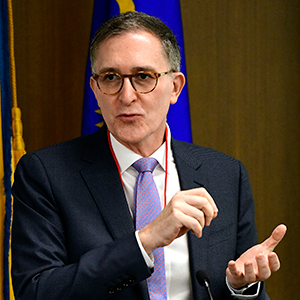At its June 1-2 virtual meeting, the National Advisory Environmental Health Sciences Council (NAEHSC) turned much of its attention to an emerging scientific field called the exposome.
The term was first coined in 2005 and is conceptually similar to the genome, which involves studying an individual’s complete set of DNA to learn how certain genetic changes can lead to disease and ill health. With the exposome, the goal is to analyze all of the environmental exposures that a person experiences in his or her life. However, there is more to the equation.
 The exposome involves all exposures experienced throughout life, ranging from air pollution to psychosocial stress. (Photo courtesy of Babaroga / Shutterstock.com)
The exposome involves all exposures experienced throughout life, ranging from air pollution to psychosocial stress. (Photo courtesy of Babaroga / Shutterstock.com)Linking exposures to biological changes
 Miller serves as inaugural editor-in-chief of the journal Exposome, which launched in March and is published by Oxford University Press. (Photo courtesy of Gary Miller)
Miller serves as inaugural editor-in-chief of the journal Exposome, which launched in March and is published by Oxford University Press. (Photo courtesy of Gary Miller)“It is critical to understand that the exposome is not just about the exposures themselves but also about linking them to changes in biology — the internal signals that drive health effects,” said NIEHS grantee Gary Miller, Ph.D., from Columbia University. Last year, he published a book titled “The Exposome: A New Paradigm for the Environment and Health.”
“So, the exposome is the cumulative measure of environmental influences and the corresponding biological responses throughout the lifespan,” explained Miller.
He said that rather than attempting to measure all exposures, which is an impossible task, environmental health scientists should try to capture as many of them as possible, in the context of their specific research questions. That requires embracing new tools and approaches, such as high-resolution mass spectrometry and metabolomics, which involves large-scale analysis of metabolites, according to Miller.
To learn more about Miller’s thoughts on the exposome, check out his recent conversation with NIEHS and National Toxicology Program Director Rick Woychik, Ph.D.
A yes-brainer
 Last year, Koroshetz co-chaired a major National Academies workshop on how chemicals affect brain health and disease, and many NIEHS grantees participated. (Photo courtesy of NINDS)
Last year, Koroshetz co-chaired a major National Academies workshop on how chemicals affect brain health and disease, and many NIEHS grantees participated. (Photo courtesy of NINDS)Walter Koroshetz, M.D., director of the National Institute of Neurological Disorders and Stroke (NINDS), discussed efforts by NINDS to understand environmental influences that drive neurological diseases — what he calls the neural exposome.
“We’ve learned a tremendous amount from genetics, but now we’re seeing a ceiling, and that ceiling is pretty high, in that there is a lot of space that the genetics are not going to give us answers to,” Koroshetz said.
“Trying to make a difference in the neurologic conditions, we absolutely have to get a better handle on environmental influences and how they interact with genetics,” he added.
Koroshetz noted that NINDS will establish a new office of neural exposome science to work with NIEHS and other National Institutes of Health (NIH) institutes and centers.
Good news on funding
Woychik reported that under President Biden’s proposed 2022 federal budget, NIH and NIEHS would see significant increases in funding. NIH’s budget would expand to $52 billion, more than a 21% uptick over the 2021 congressionally approved budget.
“A large amount of this increase, $6.5 billion, is for a new program called ARPA-H, or Advanced Research Projects Agency for Health,” he said. The goal of the agency would be to speed development of medical treatments and support innovative, transformational health research that requires extensive coordination and collaboration.
 Woychik noted that the NIEHS Superfund Research Program is slated for an approximately $2 million funding increase under the President’s proposed budget. (Photo courtesy of Steve McCaw / NIEHS)
Woychik noted that the NIEHS Superfund Research Program is slated for an approximately $2 million funding increase under the President’s proposed budget. (Photo courtesy of Steve McCaw / NIEHS)NIEHS would receive an additional $100 million to advance research into the human health effects of climate change. The institute’s total budget would equal $937.1 million.
“If you add it all up, it’s actually pretty good news,” said Woychik. “But it is not the final budget. Congress still needs to weigh in.”
Focused on diversity, equity, and inclusion
Woychik also described the UNITE initiative, a new NIH-wide program aimed at addressing structural racism within the greater scientific community. Goals include the following:
- U — Understanding stakeholder experiences through listening and learning.
- N — New research on health disparities, minority health, and health equities.
- I — Improving NIH culture and structure for equity, inclusion, and excellence.
- T — Transparency, communication, and accountability with our internal and external stakeholders.
- E — Extramural research ecosystem: changing policy, culture, and structure to promote workforce diversity.
“Changing the culture is key,” said Karen Vasquez, Ph.D., from the University of Texas at Austin. She chairs the NAEHSC working group on anti-racism, diversity, inclusion, and equity, which was launched at the last council meeting, held in February.
Citations:
Wild CP. 2005. Complementing the genome with an 'exposome': the outstanding challenge of environmental exposure measurement in molecular epidemiology. Cancer Epidemiol Biomarkers Prev 14(8):1847–1850.
Miller GW. 2020. The Exposome: A New Paradigm for the Environment and Health. 2nd ed. Cambridge, MA: Academic Press.
Vermeulen R, Schymanski EL, Barabasi AL, Miller GW. 2020. The exposome and health: where chemistry meets biology. Science 367(6476):392–396.
(Ernie Hood is a contract writer for the NIEHS Office of Communications and Public Liaison.)









